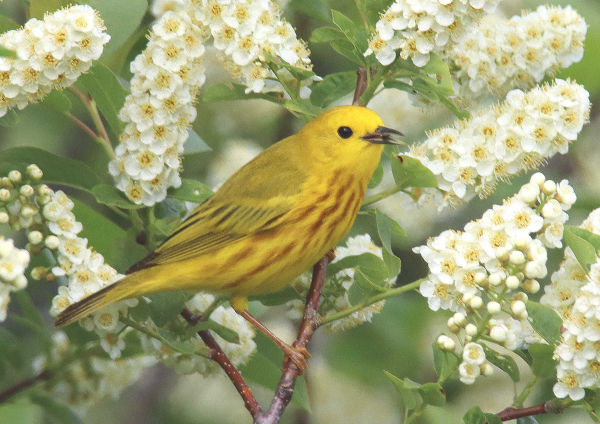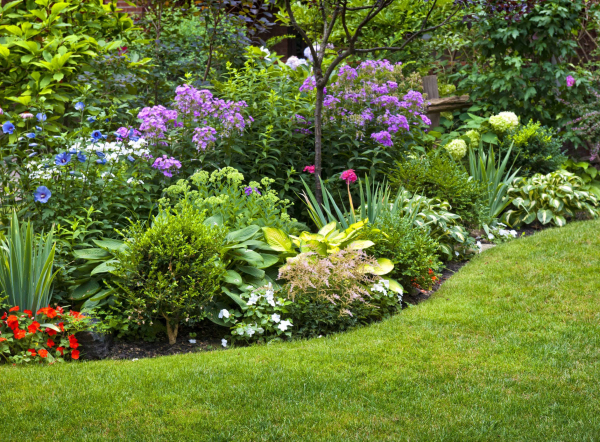
Many colorful songbirds will be attracted to flowering trees to search for tiny insects, like this Yellow Warbler among chokecherry blooms (photo by Paul Konrad).

A few simple design options can add to the plants you feature in flower gardens and landscaped areas of your yards, like using curved borders and “flower circles.”

If you live within the range of mulberry trees, their fruits are an impressive magnet that attracts a variety of birds, including tanagers, orioles, thrushes, waxwings, woodpeckers, and more (Scarlet Tanager among mulberry fruits, photo by Paul Konrad).
|
It becomes especially interesting each spring when birding and gardening combine in your own yard! Planting and maintaining a garden and freshening the landscaping in your yard is an annual rite of spring, and what we plant and create during spring often remains part of our yard throughout the rest of the year. Our landscaping and gardening activities can benefit seasons of birds, beginning with the birds of spring and continuing through summer, fall, and winter – all while beautifying our yards, getting a little exercise in the process, and serving the biggest variety of birds during spring migration, the nesting period, and into fall migration.
Think of your yard as a potential bird oasis that provides a mix of micro-habitats that will attract birds. And think of the birds that visit your yard and use its resources, whether it’s for a moment or a season, as something of a parade of birds, ever-changing, but with some periodic short-term residents. Some birds may choose your yard to build a nest and reproduce during the nesting season, which can be the grandest of all backyard birding achievements – to provide nesting habitat through landscaping. Yardscaping with birds in mind, combined with a feeding station with a variety of foods and water, will surely give birds a boost during migration and nesting periods.
Today, yard by yard, it all adds up to important and improved backyard habitats that we can share with birds that rely more and more on our focus to benefit birds. And that meshes beautifully with the theme of this year’s upcoming World Migratory Bird Day, “Shared Spaces: Creating Bird-friendly Cities and Communities.” Each bird-friendly space in every neighborhood is valuable in some way to some birds, season after season.
Let’s start with something simple, like a hummingbird flower garden, maybe two, that emphasize red and yellow tubular flowers, the best at making sugar-based nectar that attracts and benefits hummingbirds of every kind. The hummingbirds that visit our yard really zero in on red salvia, red trumpet vines, red cardinal flowers, and bee balm blooms. All flowers attract small insects that hummingbirds feed on too. Similarly, you can plant a “seed garden” with a variety of native seed-producing plants, plus giant sunflowers that goldfinches, native sparrows, and other birds will appreciate when they mature.
Have some fun and design your yard with a little more flare by adding some new circles and ovals of flower color to break up what may be a monotony of mowed grass. We have found these “flower circles” to add a lot of character to our yard that just wasn’t there before, and it gives hummingbirds and others another location to search for food. Also, rather than traditional straight-line borders to the edges of gardens and shrubby areas, we have created curved and wavy borders to break up the traditional sharp lines of planted flowers, shrubs, and trees.
Another way to break up a part of an extensive mowed lawn is to designate areas to let the grass grow tall, mature, and create seed heads in selected oval areas, and along the borders of a hedge or another landscaping feature. Similar to “flower circles”, “grass ovals” will also add a different micro-habitat for birds to explore and search for foods. The resulting tall grass cover can add a flair to your landscaping, and the heads of grass seeds will attract ground feeding birds. We like the way the tall grass catches the wind, and even after it dries during fall it adds another dimension color and movement in our yard. Of course, there are decorative grasses you can plant for added effect too.
Something New
Each year we tend to add a new tree or a couple bushes to add to our already birdy yard. A single tree can make a big difference to the way your yard looks, and it can increase the attractiveness of your yard to some birds. We give trees, shrubs, and other plants that produce fruits or berries an added emphasis, and while mulberries, and flowering cherries and crabapple trees can be bird magnets during spring, most fruiting trees and shrubs will be a benefit for late summer and fall avian visitors.
When planning what plants to add to your yard and where to plant them, it’s important to consider what parts of your yard are sunny and where there is shade. Some plants prefer one or the other, so you will want to plant them in an appropriate location. Then too, sunny areas and shaded areas will probably change from morning to afternoon and evening, so keep that in mind too. Another basic design consideration to keep is to arrange gardens and landscaping by elevations, with short plants in the front, taller plants in the rear; or tall plants in the middle surrounded by medium-sized plants and smaller ones.
Many people appreciate how mixing deciduous and coniferous trees and bushes adds shades of color and depth to areas of their yard. At the same time, think about how these larger landscaping plants provide nesting cover, as well as escape cover for birds. As a relatively large-scale example, we have a 100-foot expanse of trees that includes 3 kinds of short trees, including chokecherries and wild plums that add cover, nesting sites, and attractive berries for birds to feed on. A significant spruce tree is a centerpiece that helps to anchor the other smaller trees, as does a maple tree and a number elm trees. All of these trees provide foraging areas, shade, escape and roosting cover, and potential nesting sites for a variety of birds.
Whether you live in an apartment or condo, have a city yard, or a larger property, potted plants are always great additions to your balcony, patio, deck, or yard. Think big pots – pots that small trees and bushes can live in. Big pots can also be used to plant climbing trumpet vines in them, which are often preferred by hummingbirds, and are a great addition to any yard or balcony. The same goes for sunflowers, although finches will be more interested in their seeds.
Imagine how traditional backyard birding elements can be enhanced through gardening options too: Like adding flowering plants to improve the look around your feeding station. Even a decorative birch or aspen branch positioned near a feeder will provide an accent to the site while providing a new perch for birds. Adding a couple large rocks or a decorative log can add accented natural ingredients to your landscaping too, while acting as new perches for birds that visit your feeding station and birdbath. Speaking of birdbaths, consider adding a natural-looking water feature that includes the trickle of running water to your yard – a pleasing sound for you, and a sound that acts as a magnet for birds.
Local greenhouses and nurseries are filling with the colors of spring and the promise of bountiful days ahead. And migrating birds are bringing new colors and songs to our yards with the promise of more to birds to follow. Enjoy the spring birding season, in your yard and beyond!
Share your backyard birding experiences and photographs with The Birding Wire at editorstbw2@gmail.com